A Broad Dual-Band Bandpass Filter Design Based on Double-Layered Spoof Surface Plasmon Polaritons
Abstract
:1. Introduction
2. Materials and Methods
3. Structure and Parametric Study
3.1. Structure and Parametric Study of DLSSPW Loaded with a Single CSDMR
3.2. Structure of a Second-Order Dual-Band Bandpass Filter and Simulation Results
4. Results and Discussion
5. Conclusions
Author Contributions
Funding
Data Availability Statement
Conflicts of Interest
References
- Atwater, H. The Promise of Plasmonics. Sci. Am. 2007, 296, 56–62. [Google Scholar] [CrossRef] [PubMed]
- Yu, N.; Wang, Q.J.; Kats, M.; Fan, J.A.; Khanna, S.P.; Li, L.; Davies, A.; Linfield, E.; Capasso, F. Designer spoof surface plasmon structures collimate terahertz laser beams. Nat. Mater. 2010, 9, 730–735. [Google Scholar] [CrossRef] [PubMed]
- Ma, H.F.; Shen, X.P.; Cheng, Q.; Jiang, W.X.; Cui, T.J. Broad-band and high-efficiency conversion from guided waves to spoof surface plasmon polaritons. Laser Photonics 2013, 8, 146–151. [Google Scholar] [CrossRef]
- Shen, X.; Cui, T.J. Planar plasmonic metamaterial on a thin film with nearly zero thickness. Appl. Phys. Lett. 2013, 102, 211909. [Google Scholar] [CrossRef]
- Pendry, J.B.; Martín-Moreno, L.; Garcia-Vidal, F.J. Mimicking Surface Plasmons with Structured Surfaces. Science 2004, 305, 847–848. [Google Scholar] [CrossRef]
- Garcia-Vida, F.J.; Martin-Moreno, L.; Pendry, J.B. Surfaces with holes in them: New plasmonic metamaterials. J. Opt. A Pure Appl. Opt. 2005, 7, 97–101. [Google Scholar] [CrossRef] [Green Version]
- Hibbins, A.P.; Evans, B.R.; Sambles, J.R. Experimental Verification of Designer Surface Plasmons. Science 2005, 308, 670–672. [Google Scholar] [CrossRef] [Green Version]
- Barnes, W.L.; Dereux, A.; Ebbesen, T.W. Surface plasmon subwavelength optics. Nature 2003, 424, 824–830. [Google Scholar] [CrossRef]
- Ebbesen, T.W.; Genet, C.; Bozhevolnyi, S.I. Surface-plasmon circuitry. Phys. Today 2008, 61, 44–50. [Google Scholar] [CrossRef] [Green Version]
- Shen, X.; Cui, T.J.; Cano, D.M.; Garcia-Vidal, F.J. Conformal surface plasmons propagating on ultrathin and flexible films. Proc. Natl. Acad. Sci. USA 2013, 110, 40–45. [Google Scholar] [CrossRef] [Green Version]
- Liu, L.; Li, Z.; Gu, C.; Ning, P.; Xu, B.; Niu, Z.; Zhao, Y. Multi-channel composite spoof surface plasmon polaritons propagating along periodically corrugated metallic thin films. J. Appl. Phys. 2014, 116, 013501. [Google Scholar] [CrossRef]
- Williams, C.R.; Andrews, S.R.; Maier, S.; Fernandez-Dominguez, A.I.; Martín-Moreno, L.; Garcia-Vidal, F. Highly confined guiding of terahertz surface plasmon polaritons on structured metal surfaces. Nat. Photonics 2008, 2, 175–179. [Google Scholar] [CrossRef]
- Navarro-Cía, M.; Beruete, M.; Agrafiotis, S.; Falcone, F.; Sorolla, M.; Maier, S. Broadband spoof plasmons and subwavelength electromagnetic energy confinement on ultrathin metafilms. Opt. Express 2009, 17, 18184–18195. [Google Scholar] [CrossRef] [PubMed] [Green Version]
- Jiang, T.; Shen, L.; Wu, J.-J.; Yang, T.-J.; Ruan, Z.; Ran, L. Realization of tightly confined channel plasmon polaritons at low frequencies. Appl. Phys. Lett. 2011, 99, 261103. [Google Scholar] [CrossRef]
- Wang, J.; Zhao, L.; Hao, Z.-C. A Band-Pass Filter Based on the Spoof Surface Plasmon Polaritons and CPW-Based Coupling Structure. IEEE Access 2019, 7, 35089–35096. [Google Scholar] [CrossRef]
- Wang, J.; Zhao, L.; Hao, Z.-C.; Cui, T.J. An ultra-thin coplanar waveguide filter based on the spoof surface plasmon polaritons. Appl. Phys. Lett. 2018, 113, 071101. [Google Scholar] [CrossRef]
- Wang, J.; Zhao, L.; Hao, Z.-C.; Shen, X.; Cui, T.J. Splitting spoof surface plasmon polaritons to different directions with high efficiency in ultra-wideband frequencies. Opt. Lett. 2019, 44, 3374–3377. [Google Scholar] [CrossRef]
- Tsai, W.-H.; Tsao, Y.-C.; Lin, H.-Y.; Sheu, B.-C. Cross-point analysis for a multimode fiber sensor based on surface plasmon resonance. Opt. Lett. 2005, 30, 2209–2211. [Google Scholar] [CrossRef]
- Ozbay, E. Plasmonics: Merging Photonics and Electronics at Nanoscale Dimensions. Science 2006, 311, 189–193. [Google Scholar] [CrossRef]
- Kawata, S.; Inouye, Y.; Verma, P. Plasmonics for near-field nano-imaging and superlensing. Nat. Photonics 2009, 3, 388–394. [Google Scholar] [CrossRef]
- Gramotnev, D.K.; Bozhevolnyi, S.I. Plasmonics beyond the diffraction limit. Nat. Photonics 2010, 4, 83–91. [Google Scholar] [CrossRef]
- Polman, A.; Atwater, H. Photonic design principles for ultrahigh-efficiency photovoltaics. Nat. Mater. 2012, 11, 174–177. [Google Scholar] [CrossRef] [PubMed]
- Zhang, Q.; Zhang, H.C.; Wu, H.; Cui, T.J. A Hybrid Circuit for Spoof Surface Plasmons and Spatial Waveguide Modes to Reach Controllable Band-Pass Filters. Sci. Rep. 2015, 5, 16531. [Google Scholar] [CrossRef]
- Chen, Z.-M.; Liu, Y.; Liang, X.; Wang, J.; Li, Y.; Zhu, J.; Jiang, W.; Shen, X.; Zhao, L.; Cui, T.J. A High Efficiency Band-Pass Filter Based on CPW and Quasi-Spoof Surface Plasmon Polaritons. IEEE Access 2019, 8, 4311–4317. [Google Scholar] [CrossRef]
- Ye, L.; Chen, Y.; Da Xu, K.; Li, W.; Liu, Q.H.; Zhang, Y. Substrate Integrated Plasmonic Waveguide for Microwave Bandpass Filter Applications. IEEE Access 2019, 7, 75957–75964. [Google Scholar] [CrossRef]
- Yin, J.Y.; Ren, J.; Zhang, H.C.; Pan, B.C.; Cui, T.J. Broadband Frequency-Selective Spoof Surface Plasmon Polaritons on Ultrathin Metallic Structure. Sci. Rep. 2015, 5, 8165. [Google Scholar] [CrossRef] [PubMed]
- Zhao, L.; Zhang, X.; Wang, J.; Yu, W.; Li, J.; Su, H.; Shen, X. A Novel Broadband Band-pass Filter Based on Spoof Surface Plasmon Polaritons. Sci. Rep. 2016, 6, 36069. [Google Scholar] [CrossRef]
- Gao, X.; Zhou, L.; Liao, Z.; Ma, H.F.; Cui, T.J. An ultra-wideband surface plasmonic filter in microwave frequency. Appl. Phys. Lett. 2014, 104, 191603. [Google Scholar] [CrossRef]
- Calabrese, G.; Corfdir, P.; Gao, G.; Pfüller, C.; Trampert, A.; Brandt, O.; Geelhaar, L.; Fernández-Garrido, S. Molecular beam epitaxy of single crystalline GaN nanowires on a flexible Ti foil. Appl. Phys. Lett. 2016, 108, 202101. [Google Scholar] [CrossRef] [Green Version]
- Yang, L.; Zhou, Y.J.; Zhang, C.; Xiao, Q.X. Compact wideband plasmonic filter with flat-top transmission response based on corrugated metal-insulator-metal ring resonator. Sci. Rep. 2017, 7, 14237. [Google Scholar] [CrossRef] [Green Version]
- Guo, Y.J.; Da Xu, K.; Liu, Y.; Tang, X. Novel Surface Plasmon Polariton Waveguides with Enhanced Field Confinement for Microwave-Frequency Ultra-Wideband Bandpass Filters. IEEE Access 2018, 6, 10249–10256. [Google Scholar] [CrossRef]
- Gao, X.; Shi, J.; Shen, X.; Ma, H.F.; Jiang, W.X.; Li, L.; Cui, T.J. Ultrathin dual-band surface plasmonic polariton waveguide and frequency splitter in microwave frequencies. Appl. Phys. Lett. 2013, 102, 151912. [Google Scholar] [CrossRef]
- Pan, B.C.; Liao, Z.; Zhao, J.; Cui, T.J. Controlling rejections of spoof surface plasmon polaritons using metamaterial particles. Opt. Express 2014, 22, 13940–13950. [Google Scholar] [CrossRef]
- Jaiswal, R.K.; Pandit, N.; Pathak, N.P. Spoof Surface Plasmon Polaritons Based Reconfigurable Band-Pass Filter. IEEE Photonics Technol. Lett. 2018, 31, 218–221. [Google Scholar] [CrossRef]
- Shang, H.; Liu, Y.; Li, Z.; Tian, Y. Broadband bandpass filter with double-layered spoof surface plasmon waveguide as main transmission line. Int. J. RF Microw. Comput. Eng. 2020, e22440. [Google Scholar] [CrossRef]
- Matthaei, G.L. Microwave filters, impedance-matching networks, and coupling structures. Proc. IEEE 1964, 53, 766. [Google Scholar] [CrossRef]
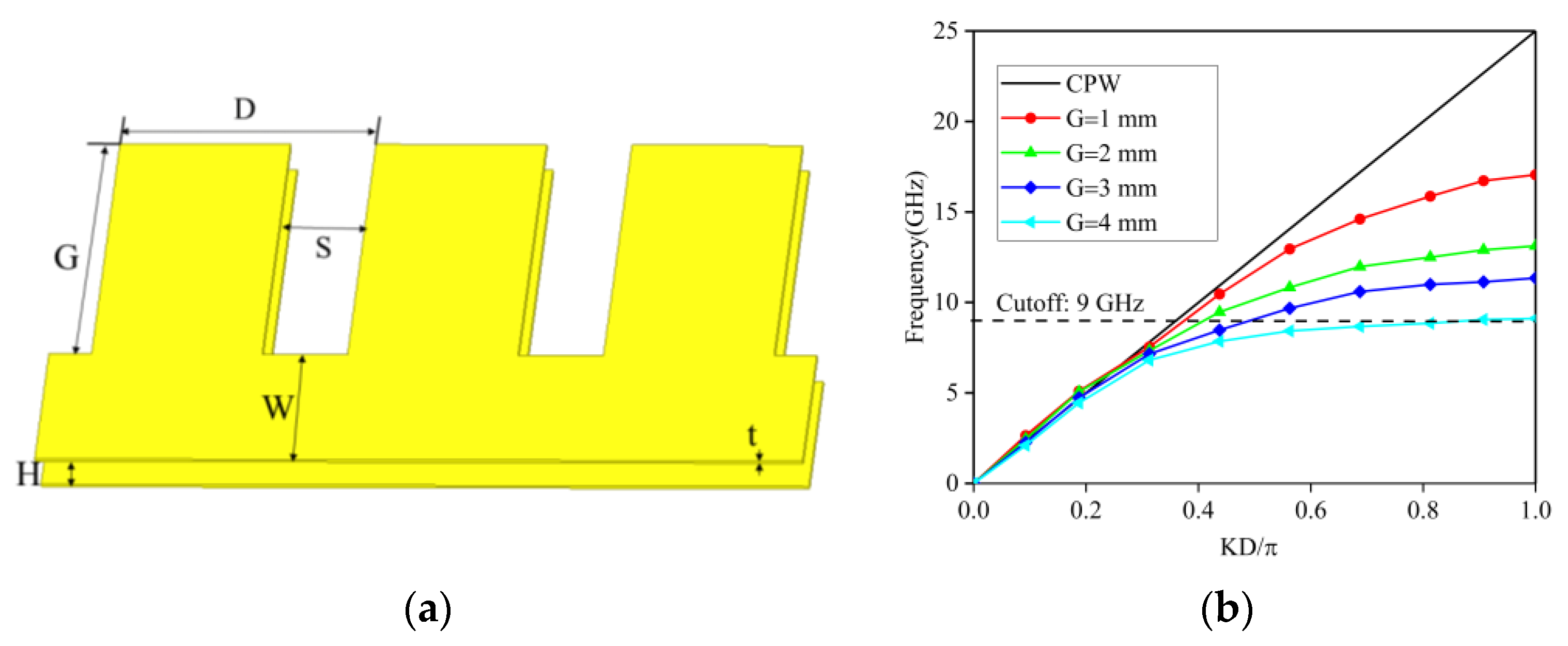
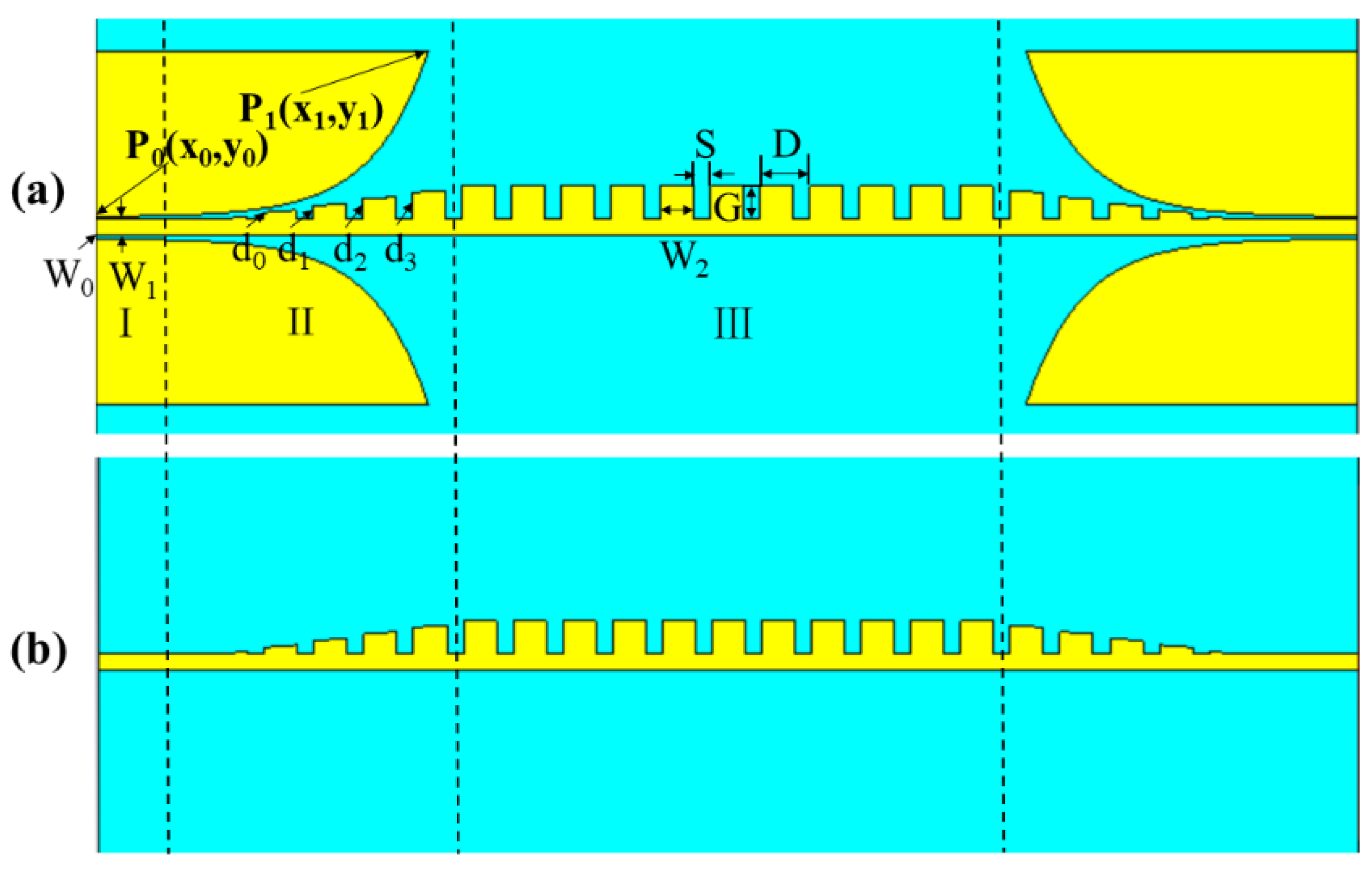
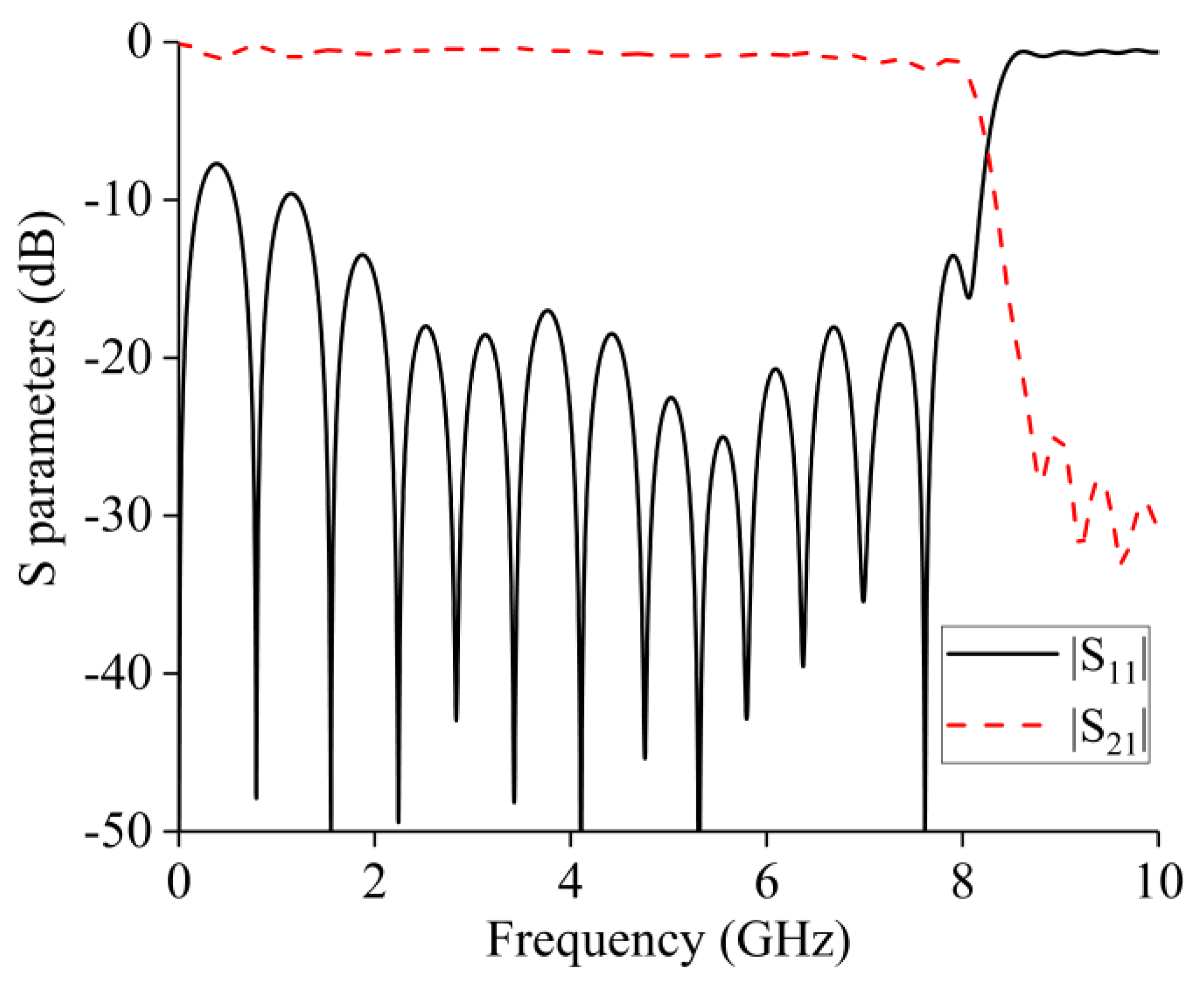

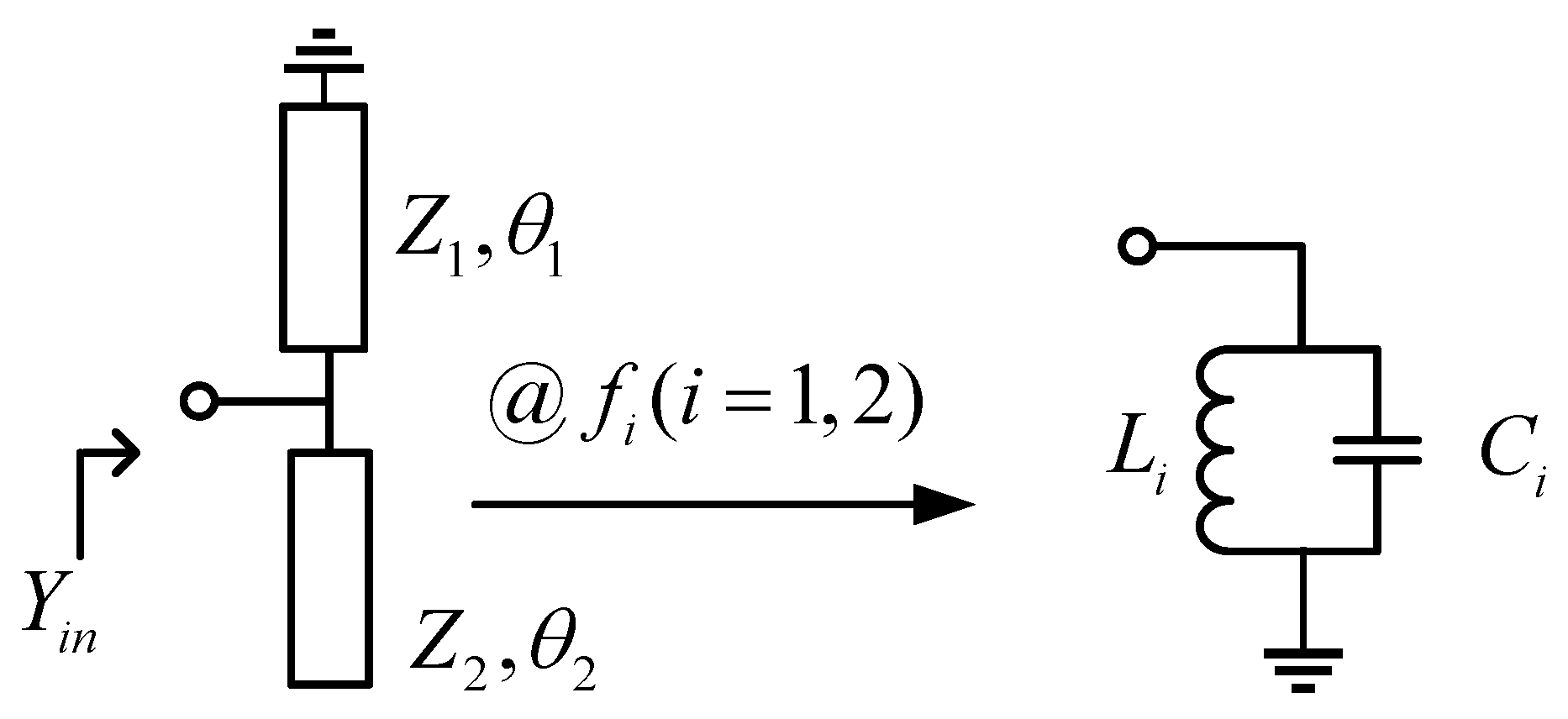
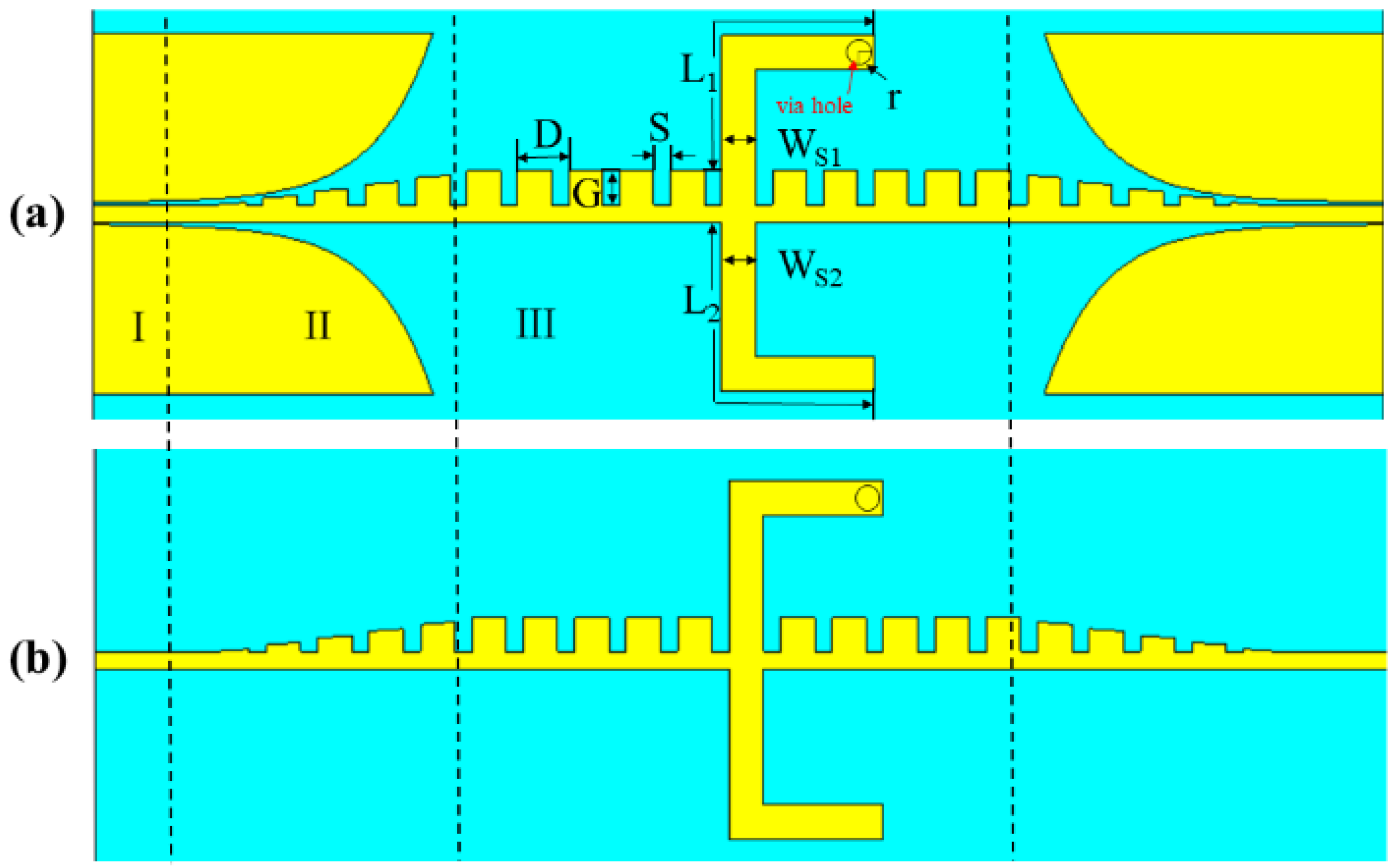
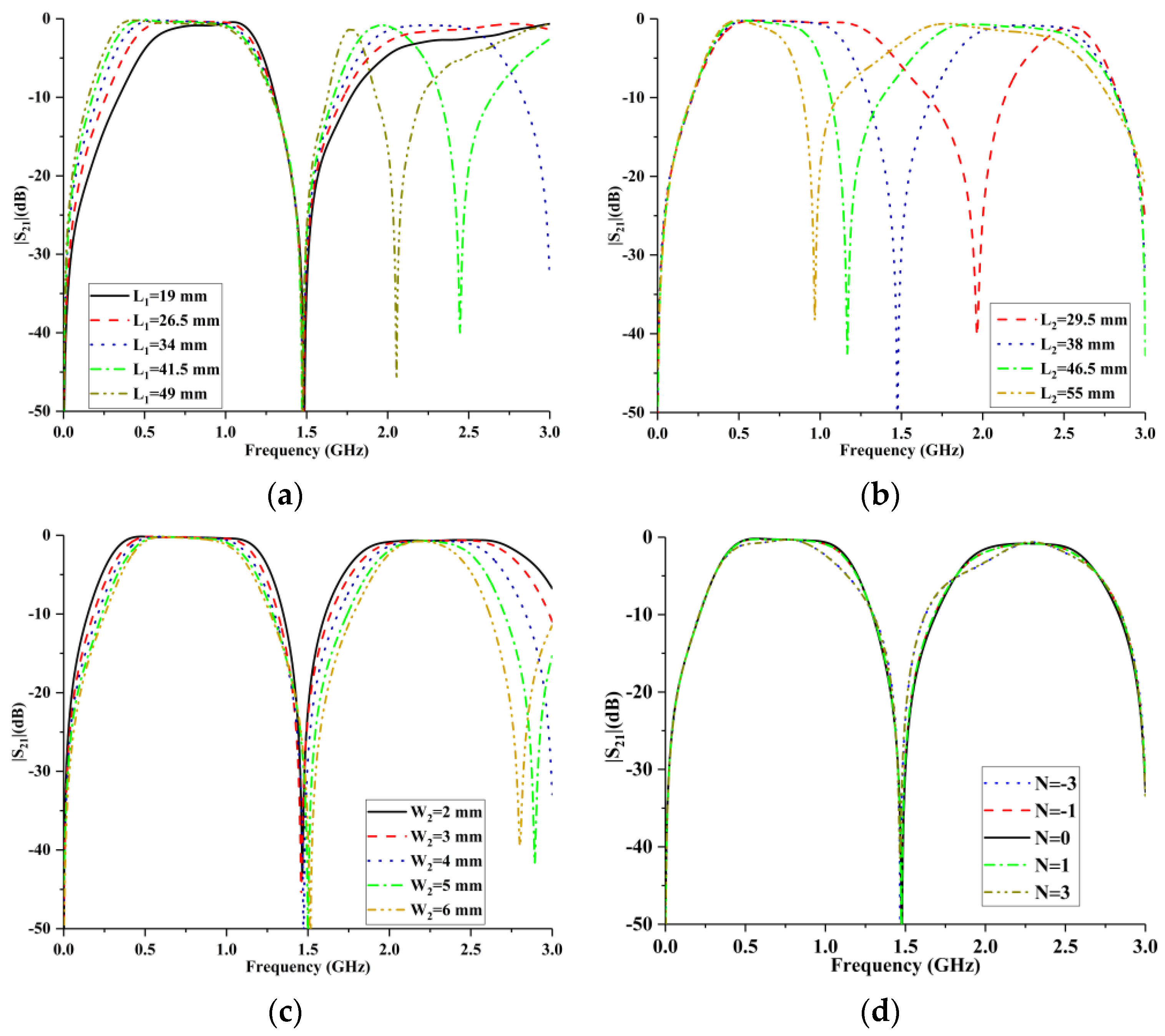
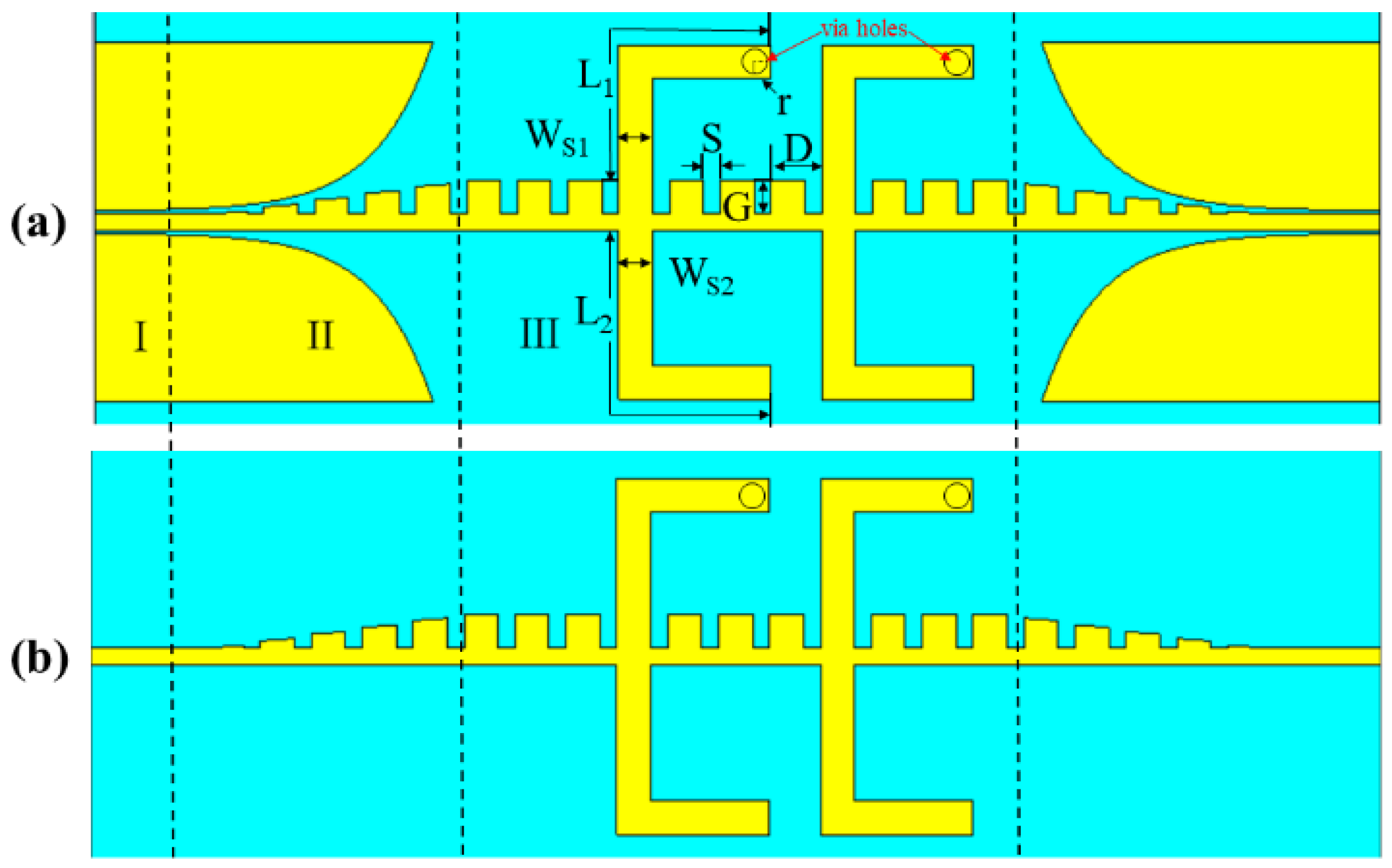
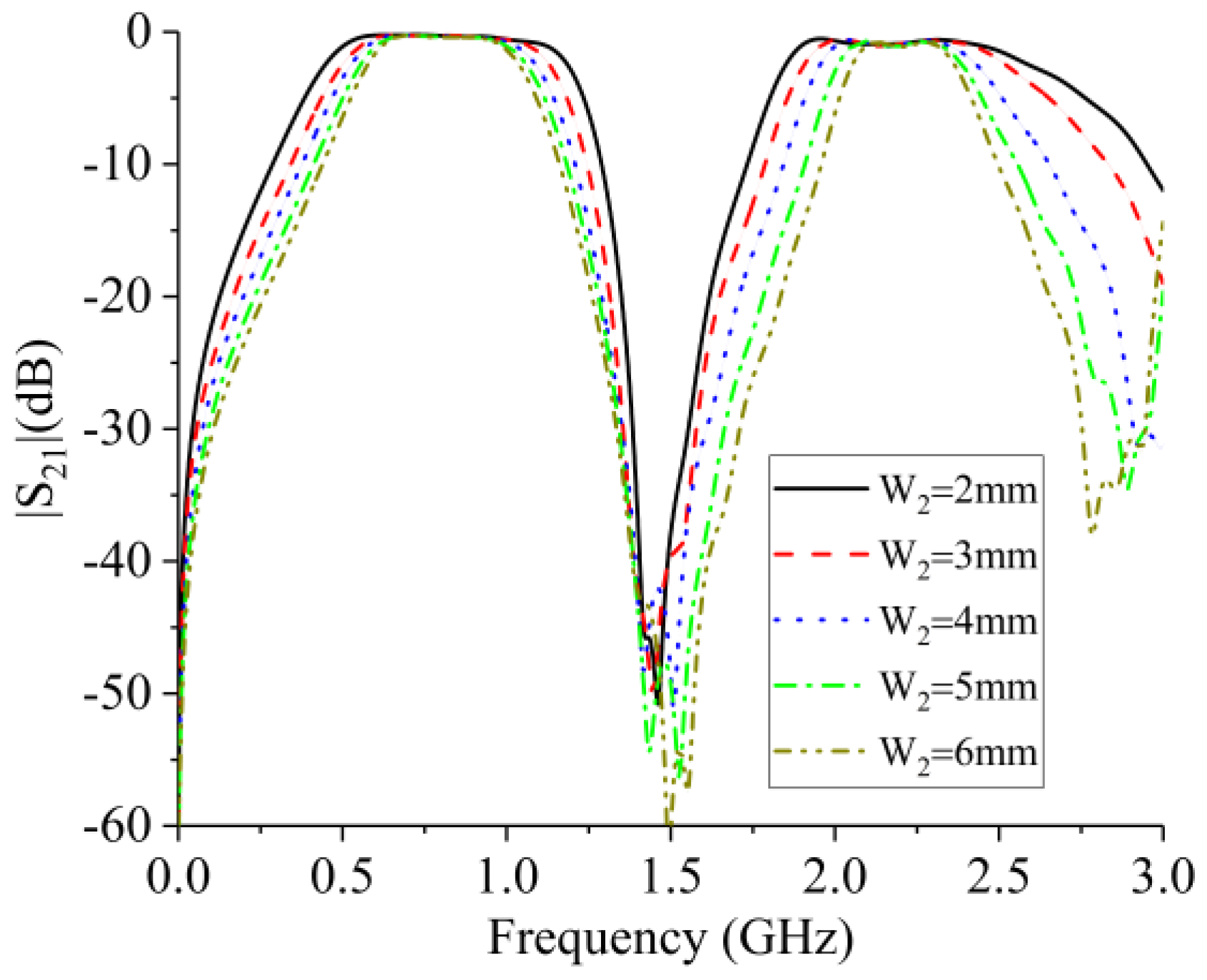



| Ref. | Tech. Type | Mea. Operating Frequency | Mea. IL (dB) | Mea. RL (dB) | Mea. FBW (%) | Size (λg × λg) |
|---|---|---|---|---|---|---|
| [23] | HSIW | 11.92–21.54 | 0.5–3 | >10 | 57.5 | 6.95 × 1.1 |
| [24] | QSSPPs | 7.5–15.5 | 0.2–1 | >15 | 63.6 | 1.07 × 0.43 |
| [25] | SIPW | 7.5–11.8 | 1–4 | >15 | 53.7 | 2.3 × 0.77 |
| [26] | SLSSPPs | 7–10 | 2.5–3.5 | >10 | 35.3 | 7.45 × 1.16 |
| [27] | SLSSPPs | 7–10 | N/A | >10 | 35.3 | 6.34 × 1.29 |
| [31] | SLSSPPs | 2.1–8 | 2–5 | >10 | 116 | 0.94 × 0.38 |
| [33] | DLSSPPs | 2.3–7.1 | 2 min | >10 | 102 | 3.68 × 0.93 |
| This work | DLSSPPs | 0.7–1.1 2.05–2.48 | 1.5–2.5 2–2.5 | >10 >10 | 44.4 19 | 0.76 × 0.21 |
Publisher’s Note: MDPI stays neutral with regard to jurisdictional claims in published maps and institutional affiliations. |
© 2022 by the authors. Licensee MDPI, Basel, Switzerland. This article is an open access article distributed under the terms and conditions of the Creative Commons Attribution (CC BY) license (https://creativecommons.org/licenses/by/4.0/).
Share and Cite
Liu, L.; Liu, Y.; Jin, X.; Li, Z.; Tian, Y. A Broad Dual-Band Bandpass Filter Design Based on Double-Layered Spoof Surface Plasmon Polaritons. Electronics 2022, 11, 697. https://doi.org/10.3390/electronics11050697
Liu L, Liu Y, Jin X, Li Z, Tian Y. A Broad Dual-Band Bandpass Filter Design Based on Double-Layered Spoof Surface Plasmon Polaritons. Electronics. 2022; 11(5):697. https://doi.org/10.3390/electronics11050697
Chicago/Turabian StyleLiu, Lingyun, Yun Liu, Xiaohua Jin, Zhuo Li, and Yubo Tian. 2022. "A Broad Dual-Band Bandpass Filter Design Based on Double-Layered Spoof Surface Plasmon Polaritons" Electronics 11, no. 5: 697. https://doi.org/10.3390/electronics11050697






